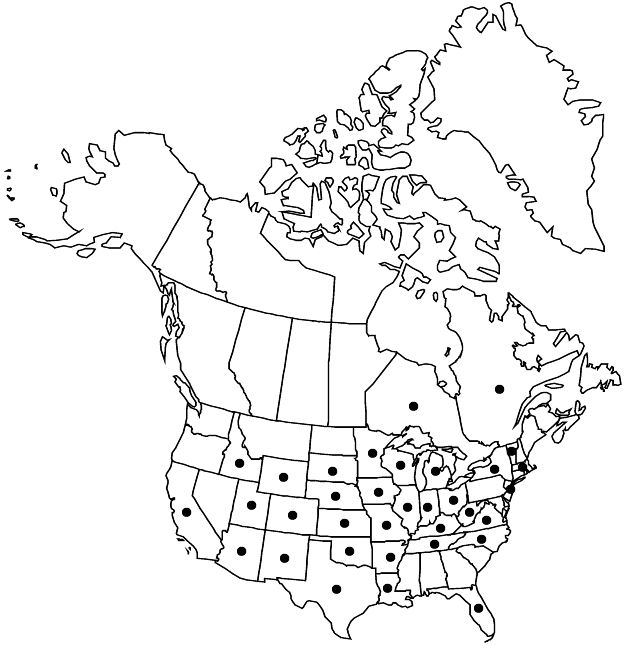Euphorbia davidii
Kurtziana 17: 125, figs. 1, 2H–J. 1984.
Herbs, annual, with taproot. Stems erect or ascending, 20–70 cm, both coarsely and sparsely hirsute and closely strigillose; branches usually ± straight, occasionally proximal branches arcuate. Leaves usually opposite, occasionally alternate at distal nodes; petiole 7–25 mm, strigose; blade usually narrowly to broadly elliptic, occasionally lance-elliptic, 10–100 × 5–35 mm, base cuneate to attenuate, margins coarsely crenate-dentate, strigose, revolute to nearly flat, apex broadly acute to acuminate, or obtuse, abaxial surface strigose with stiff, strongly tapered hairs, adaxial surface sparsely strigose-hirsute; venation pinnate, midvein prominent. Cyathial arrangement: terminal pleiochasial branches usually 3, occasionally reduced to congested cyme, 1–2-branched; pleiochasial bracts 2–4, often whorled, green with diffuse greenish white to mauve near base, similar in shape and size to distal leaves or slightly narrower; dichasial bracts similar in shape to distal leaves but smaller, often highly reduced. Cyathia: peduncle 0.5–1 mm. Involucre cylindric, 2.5–3 × 1.3–1.8 mm, glabrous; involucral lobes divided into 5–7 linear, papillate lobes; gland 1, yellow-green, sessile and broadly attached, 0.9 × 1.3 mm, opening oblong, glabrous; appendages absent. Staminate flowers 5–8. Pistillate flowers: ovary glabrous or sparsely strigose; styles 1 mm, 2-fid 1/2 to nearly entire length. Capsules broadly ovoid, 2.9–3.3 × 4–4.8 mm, 3-lobed, glabrous; columella 2.2–2.7 mm. Seeds black to brown or pale gray, ovoid to triangular-ovoid, angular in cross section, 2.4–2.9 × 2.2–2.9 mm, low-tuberculate, tubercles irregularly arranged or in faint, transverse row; caruncle 0.9–1.1 mm. 2n = 56.
Phenology: Flowering and fruiting summer–fall.
Habitat: Forests, stream and riverbanks, prairies, roadsides and open disturbed areas.
Elevation: 200–1500 m.
Distribution

Ont., Que., Ariz., Ark., Calif., Colo., Fla., Idaho, Ill., Ind., Iowa, Kans., Ky., La., Mass., Mich., Minn., Mo., Nebr., N.J., N.Mex., N.Y., N.C., Ohio, Okla., S.Dak., Tenn., Tex., Utah, Vt., Va., W.Va., Wis., Wyo., Mexico (Chihuahua, Coahuila, Sonora), introduced in South America, Eurasia (China, Russia), Australia.
Discussion
Euphorbia davidii is native from the southwestern United States and northern Mexico north through the southern Great Plains; it apparently is adventive elsewhere. The species is the weediest member of the E. dentata species group (following M. H. Mayfield 1997) and has become an agricultural weed in North America, South America (for example, Argentina), and in the Old World (particularly Australia and Russia). Euphorbia davidii can be distinguished from the closely similar E. dentata by its larger capsules and seeds, often more elliptic leaves, and shorter, stiffer hairs.
Selected References
None.